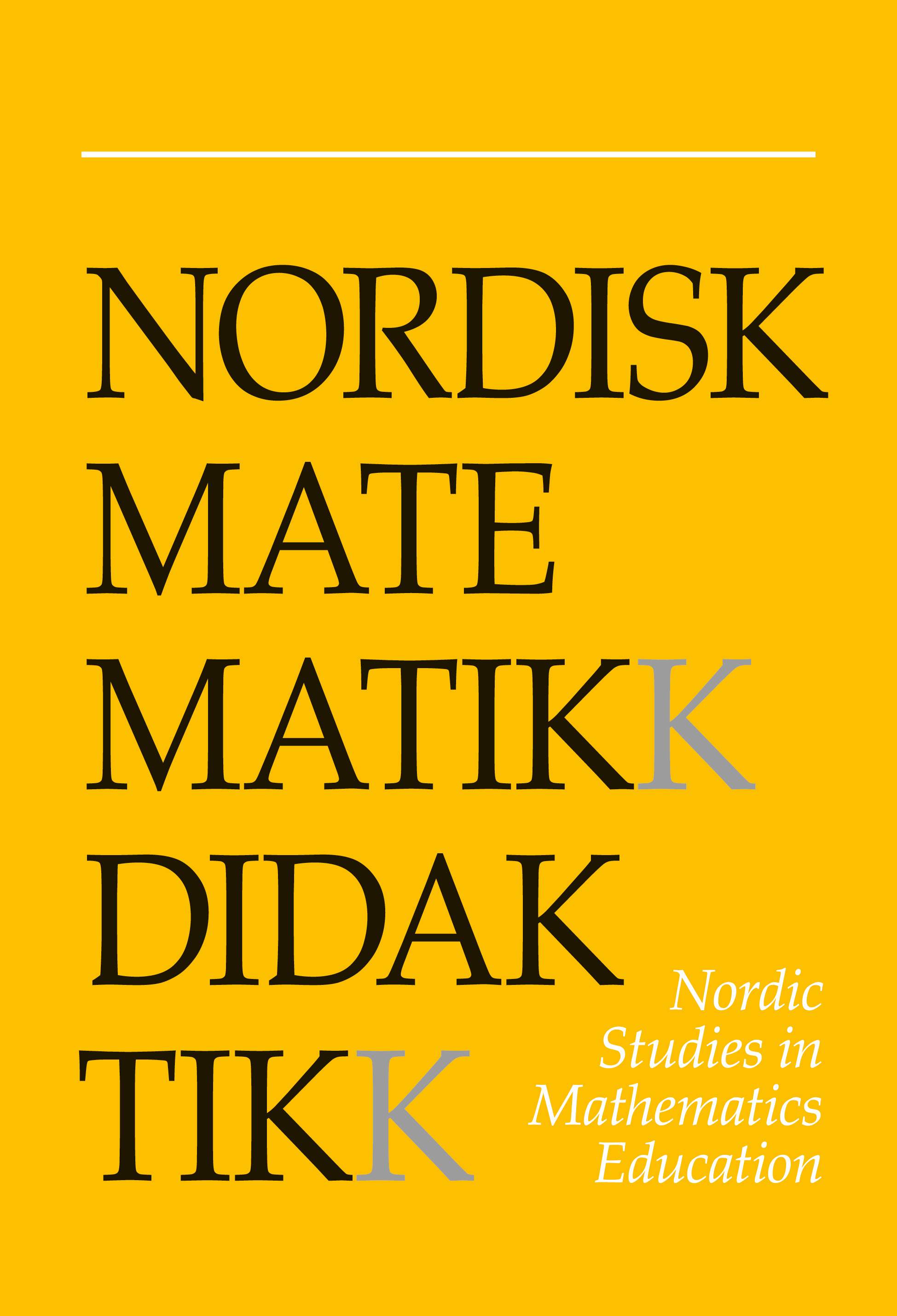Finding Erik and Alva: uncovering students who reason additively when multiplying
DOI:
https://doi.org/10.7146/nomad.v21i2.148728Abstract
This article presents a study in which grade 5 students’ responses to multiplicative comparison problems, a well-known method for distinguishing additive reasoning from multiplicative, are compared to their reasoning when calculating uncontextualised multiplicative tasks. Despite recognising the multiplicative structure of multiplicative comparison problems a significant proportion of students calculated multiplicative problems additively. Therefore, multiplicative comparison problems are insufficient on their own as indicators of multiplicative reasoning.
References
Bakker, M., Heuvel-Panhuizen, M. van den & Robitzsch, A. (2014). First- graders' knowledge of multiplicative reasoning before formal instruction in this domain. Contemporary Educational Psychology, 39 (1), 59-73. https://doi.org/10.1016/j.cedpsych.2013.11.001
Barmby, P., Harries, T., Higgins, S. & Suggate, J. (2009). The array representation and primary children's understanding and reasoning in multiplication. Educational Studies in Mathematics, 70 (3), 217-241. https://doi.org/10.1007/s10649-008-9145-1
Chandler, C. C. & Kamii, C. (2009). Giving change when payment is made with a dime: the difficulty of tens and ones. Journal for Research in Mathematics Education, 40 (2), 97-118. https://doi.org/10.2307/40539328
Clark, F. B. & Kamii, C. (1996). Identification of multiplicative thinking in children in grades 1-5. Journal for Research in Mathematics Education, 27 (1), 41-51. https://doi.org/10.2307/749196
Empson, S. B., Junk, D., Dominguez, H. & Turner, E. (2006). Fractions as the coordination of multiplicatively related quantities: a cross-sectional study of children's thinking. Educational Studies in Mathematics, 63 (1), 1-28. https://doi.org/10.1007/s10649-005-9000-6
Fernandez, C., Llinares, S., Van Dooren, W., De Bock, D. & Verschaffel, L. (2012). The development of students' use of additive and proportional methods along primary and secondary school. European Journal of Psychology of Education, 27 (3), 421-438. https://doi.org/10.1007/s10212-011-0087-0
Fischbein, E., Deir, M., Nello, M. S. & Marino, M. S. (1985). The role of implicit models in solving verbal problems in multiplication and division. Journal for Research in Mathematics Education, 16 (1), 3-17. https://doi.org/10.2307/748969
Fuson, K. C. (2003). Developing mathematical power in whole number operations. In J. Kilpatrick, W. G. Martin & D. Schifter (Eds.), A research companion to principles and standards for school mathematics (pp. 68-94). Reston: National Council of Teachers of Mathematics.
Greer, B. (1992). Multiplication and division as models of situations. In D. A. Grouws (Ed.), Handbook of research on mathematics teaching and learning (pp. 276-295). New York: Macmillan.
Heirdsfield, A. M., Cooper, T. J., Mulligan, J. & Irons, C. J. (1999). Children's mental multiplication and division strategies. In O. Zaslavsky (Ed.), Proceedings of the 23rd Psychology of Mathematics Education conference (pp. 89-96). Haifa: Israel Institute of Technology.
Lesh, R., Post, T. & Behr, M. (1988). Proportional reasoning. In J. Hiebert & M. J. Behr (Eds.), Number concepts and operations in the middle grades (pp. 93-118).Hillsdale: Lawrence Erlbaum Associates.
Mulligan, J. T. & Mitchelmore, M. C. (1997). Young children's intuitive models of multiplication and division. Journal for Research in Mathematics Education, 28 (3), 309-330. https://doi.org/10.2307/749783
Nunes, T., Bryant, P., Burman, D., Bell, D., Evans, D. & Hallett, D. (2009). Deaf children's informal knowledge of multiplicative reasoning. Journal of Deaf Studies and Deaf Education, 14 (2), 260-277. https://doi.org/10.1093/deafed/enn040
Schwartz, J. L. (1988). Intensive quantity and referent transforming arithmetic operations. In J. Hiebert & M. J. Behr (Eds.), Number concepts and operations in the middle grades (pp. 41-52). Hillsdale: Lawrence Erlbaum Associates.
Simon, M. A. (2006). Key developmental understandings in mathematics: a direction for investigating and establishing learning goals. Mathematical Thinking & Learning, 8 (4), 359-371. https://doi.org/10.1207/s15327833mtl0804_1
Sowder, J., Armstrong, B., Lamon, S., Simon, M., Sowder, L. & Thompson, A. (1998). Educating teachers to teach multiplicative structures in the middle grades. Journal of Mathematics Teacher Education, 1 (2), 127-155. https://doi.org/10.1023/A:1009980419975
Steffe, L. P. (1992). Schemes of action and operation involving composite units. Learning and Individual Differences, 4 (3), 259-309. https://doi.org/10.1016/1041-6080(92)90005-Y
Steffe, L. P. (1994). Children's multiplying schemes. In G. Harel & J. Confrey (Eds.), The development of multiplicative reasoning in the learning of mathematics (pp. 3-39). Albany: State University of New York Press.
Thompson, P. W. & Saldanha, L. A. (2003). Fractions and multiplicative reasoning. In J. Kilpatrick, W. G. Martin & D. Schifter (Eds.), A research companion to Principles and standards for school mathematics (pp. 95-113). Reston: National Council of Teachers of Mathematics.
Tzur, R., Johnson, H. L., McClintock, E., Kenney, R. H., Xin, Y. P. et al. (2013). Distinguishing schemes and tasks in children's development of multiplicative reasoning /Distinción de esquemas y tareas en el desarrollo del razonamiento multiplicativo de los niños. PNA, 7 (3), 85-101. https://doi.org/10.30827/pna.v7i3.6128
Van Dooren, W., De Bock, D., Evers, M. & Verschaffel, L. (2009). Students' overuse of proportionality on missing-value problems: how numbers may change solutions. Journal for Research in Mathematics Education, 40 (2), 187- 211.
Van Dooren, W., De Bock, D. & Verschaffel, L. (2010). From addition to multiplication ... and back: the development of students' additive and multiplicative reasoning skills. Cognition and Instruction, 28 (3), 360-381. https://doi.org/10.1080/07370008.2010.488306
Vergnaud, G. (1983). Multiplicative structures. In R. Lesh & M. Landau (Eds.), Acquisition of mathematics concepts and processes (pp. 127-174). Orlando: Academic Press.
Vergnaud, G. (1994). Multiplicative conceptual field: What and why? In G. Harel & J. Confrey (Eds.), The development of multiplicative reasoning in the learning of mathematics (pp. 41-59). Albany: State University of New York.
Vergnaud, G. (2009). The theory of conceptual fields. Human Development, 52 (2), 83-94. https://doi.org/10.1159/000202727
Downloads
Published
How to Cite
Issue
Section
License

This work is licensed under a Creative Commons Attribution-NonCommercial-ShareAlike 4.0 International License.



